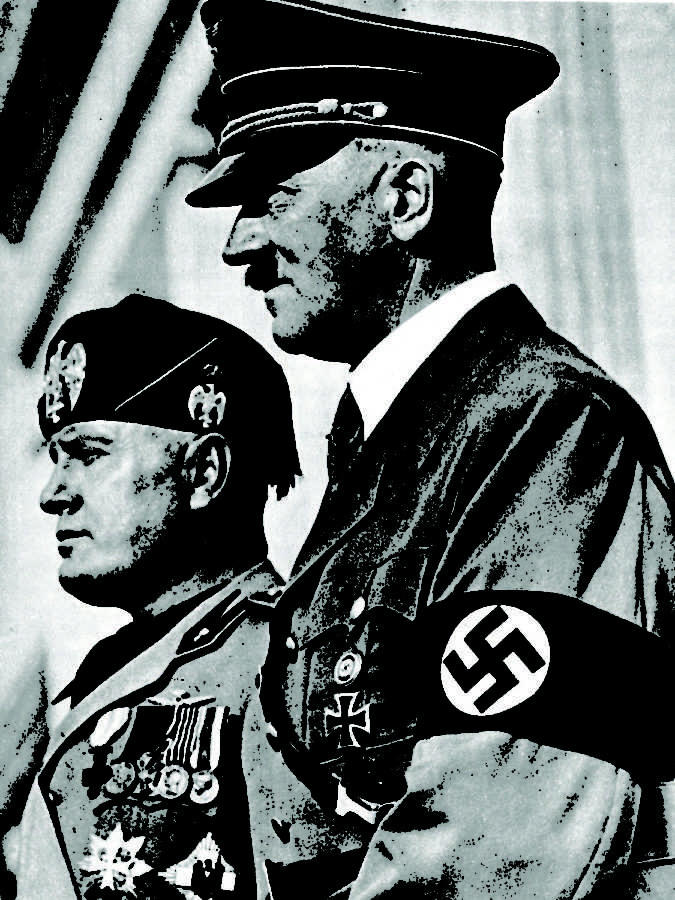Witte: Just what is fascism?
Adolph Hitler and Benito Mussolini
September 20, 2011
My colleague Jessica Bruning did an excellent job portraying conservatism, liberalism, and socialism in her series on ‘-isms’, but I feel that one more must be concentrated on before settling the matter. And that final ‘-ism’ is perhaps the most dangerous to the human condition: fascism.
When first thinking about fascism, two historical instances that come to mind are Nazi Germany and Italy under Benito Mussolini. Both of these states were totalitarian in nature and were under constant oppression. But what is fascism? It is sometimes hard to define because it has been rather isolated in occurrence and because it is such a recent phenomenon compared to other political theories.
The first and most important institution of fascism is unity. More specifically, the unity of the group. This is where the totalitarian mindset first arises. A common misconception of totalitarianism is that there must be a single ruler. Totalitarianism is merely the adherence to a single mentality by everyone – there does not have to be an authoritarian figure to have totalitarianism. It certainly facilitates the situation, as the leader is able to have sway over the actions of the group, but a leader is not always required.
Unity creates a system that not only opposes anything that is ‘other’ but seeks to either convert or eliminate them. Other political parties must not be allowed to continue; they must be dismantled. Compromise is forbidden, as it shows weakness on the dominant group’s behalf. Enormous propaganda campaigns are undertaken in order to discredit other viewpoints and portray them as not only wrong, but evil.
A common symbol of fascism is the fasces, which are a bundle of wooden sticks that are tied together, complete with an emerging axe head. This symbolizes that the individual sticks, like the individual person, are weak and unimportant isolated, but gain power only when combined into a group. If you have ever been to Washington, D.C. or watched C-SPAN, you have probably seen this symbol. It is present on the Lincoln Memorial and in the House of Representatives. However, in the American scheme, the fasces symbolizes that the pluralist collection of unique individuals acting together is the art of politics, a key foundation of this country.
Another important aspect of fascism is a very intense form of patriotism that coincides with xenophobia and ethnocentrism. This links back to that fear of the ‘other’ and the drive to either force assimilation of other cultures or bar them from entering the dominant culture to begin with. Other characteristics that go along with this powerful form of nationalism is an obedience to the state and militarism. ‘Freedom’ turns into being completely submissive to the authority, with the eradication of the private realm.
Betrayal or a sense of victimization was rampant in the formation of Nazi Germany. After World War I, Germans felt uneasiness after the Treaty of Versailles, a concern that a young demagogue named Adolf Hitler was quick to exploit. By blaming the loss of the War and the hyperinflation that soon followed on groups other than Germans, the Nazi Party went from a handful of meetings at beer halls to the verge of conquering Europe in a matter of years. Treating yourself like a victim implies that enacting ‘revenge’ on those who mistreated you is justice, no matter what the outcome.
Anti-intellectualism is also rampant within fascist cultures. Because fascist regimes forced themselves onto the masses, they obviously had to cater the lowest common denominator to attract as many as possible. Thus, intellectuals were not trusted, institutions of science and higher learning were abolished, and the exodus of intellectuals ensued. This hatred was in light of intellectuals being able to resist tyranny; they were aware of what was happening, and had the capacity to speak out against it. But they were merely a small boat trying to paddle against a torrent of volatile waters; it is only a matter of time before something has to give, and the water is very strong.
Artists were also included in this, as musicians, actors, poets, artists and the like were intimidated until they either conformed or emigrated, or worse. A complete distrust and revulsion of higher culture led to a single civil society that was controlled by the state; so interwoven was the state and civil society that the difference between the two vanished.
On the economic front, Mussolini described fascism as a ‘Third Way’ between capitalism and socialism. Where capitalism led to the pursuit of huge gains by a few, private individuals, socialism led to the inevitable class struggle – both scenarios pitted society against itself. It came to be that a corporatist state soon emerged, a state where corporations and government were linked in such a way that they were indistinguishable.
Unlike the political theories covered before by Ms. Bruning, fascism is itself not a political theory; it is rather the absence of rational political thought. It is merely a reactionary force that stems from xenophobia, ethnocentrism, intense nationalism, obedience to the state, militarism, and fierce anti-intellectualism. Sound familiar?

















